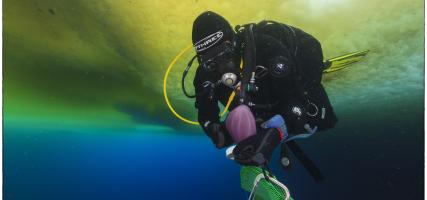
Recherche
Affiner les 84 résultats
, 2023 — Biospélélologie de l’Ouysse souterraine.. Bulletin du Comité Départemental de Spéléologie du Lot vol. 13, , p. 132-134
, avril 2023 — Large-Scale Identification of Known and Novel RRNPP Quorum-Sensing Systems by RRNPP_Detector Captures Novel Features of Bacterial, Plasmidic, and Viral Coevolution. Abstract Gram-positive Firmicutes bacteria and their mobile genetic elements (plasmids and bacteriophages) encode peptide-based… Molecular Biology and Evolution vol. 40, n° 4, ISBN: 0737-4038 Publisher: Oxford University Press (OUP) Type: 10.1093/molbev/msad062
, 2023 — Patterns of morphological variation highlight the effect of natural selection on eyespots modularity in the butterfly Morpho telemachus. Morphological correlations can not only stem from developmental constraints but also from selective pressures. Butterfly… Evolution - International Journal of Organic Evolution vol. 77, n° 2, p. 384-393 ISBN: 0014-3820 Publisher: Wiley Type: 10.1093/evolut/qpac058
, 2023 — First chromosome scale genomes of ithomiine butterflies (Nymphalidae: Ithomiini): comparative models for mimicry genetic studies. The ithomiine butterflies (Nymphalidae: Danainae) represent the largest
known radiation of Müllerian mimetic butterflies. They… Molecular Ecology Resources , , Accession Number: 36533297 ISBN: 1755-098X Publisher: Wiley/Blackwell
Type: 10.1111/1755-0998.13749
, 2023 — Patterns of morphological variation highlight the effect of natural selection on eyespots modularity in the butterfly Morpho telemachus. Morphological correlations can not only stem from developmental
constraints but also from selective pressures. Butterfly… Evolution vol. 77, , p. 384-393 ISBN: 0014-3820 Type: 10.1093/evolut/qpac058
, 2023 — Genome assembly of 3 Amazonian Morpho butterfly species reveals Z-chromosome rearrangements between closely related species living in sympatry. The genomic processes enabling speciation and species coexistence in
sympatry are still largely unknown. Here we describe the… GigaScience vol. 12, , ISBN: 2047-217X Type: 10.1093/gigascience/giad033
, 2023 — Qedemt et les espaces funéraires de Lalibela (XI¡sup¿e¡/sup¿-XXI¡sup¿e¡/sup¿ siècle). , , dir. Presses universitaires du Midi Pages: 370 p. tex.hal_id: hal-04148430 tex.hal_version: v1
, 2023 — Convergence in sympatric swallowtail butterflies reveals ecological interactions as a key driver of worldwide trait diversification. Ecological interactions can promote phenotypic diversification in
sympatric species. While competition can enhance trait… Proceedings of the National Academy of Sciences vol. 120, n° 37, e2303060120
ISSN
0027-8424, 1091-6490
, novembre 2023 — Ecological and genomic characterization of a remarkable natural heritage: a mesophotic ‘giant’ Paramuricea clavata forest. Paramuricea clavata is an ecosystem engineer, structuring hard bottom communities in the Mediterranean Sea, from 10 to 200 m… Marine Ecology Progress Series vol. SHIFT, , ISBN: 0171-8630 Publisher: Inter Research Type: 10.3354/meps14427
, septembre 2023 — « The evolutionary history of capital-breeding moths through the lens of wild silkmoths (Saturniidae) phylogenomics » in 23rd International Conference of the European Society for Lepidopterology & 11th Forum Herbulot.. Wild silkmoths (Saturniidae) are large capital-breeding insects with non-feeding adults that have short lifespan entirely… , ,
, 2023 — Corrigendum to “Molecular phylogeny and trait evolution in an ancient terrestrial arthropod lineage: Systematic revision and implications for ecological divergence (Collembola, Tomocerinae)” [Mol. Phylogenet. Evol. 154 (2021) 106995]. MOLECULAR PHYLOGENETICS AND EVOLUTION vol. 189, , p. 107926 Number: 107926 tex.earlyaccessdate: NOV 2023 tex.eissn: 1095-9513 tex.orcid-numbers: Liu, Manqiang/0000-0001-6654-7795 tex.researcherid-numbers: Liu, Manqiang/G-6566-2012 tex.unique-id: WOS:001127845800001
ISSN
1055-7903
, 2023 — Interactomics: dozens of viruses, co-evolving with humans, including the influenza A virus, may actively distort human ageing. Abstract Some viruses (e.g. HIV-1, SARS-CoV-2) have been experimentally proposed to accelerate features of human ageing and of… MOLECULAR BIOLOGY AND EVOLUTION vol. 40, n° 2, msad012
ISSN
0737-4038
, 2023 — Fast and Accurate Maximum-Likelihood Estimation of Multi-Type Birth-Death Epidemiological Models from Phylogenetic Trees. Abstract Multi-type birth-death (MTBD) models are phylodynamic analogies of compartmental models in classical epidemiology… Systematic Biology , , syad059
ISSN
1063-5157, 1076-836X
, 2023 — Modeling Drug Resistance Emergence and Transmission in HIV-1 in the UK. A deeper understanding of HIV-1 transmission and drug resistance mechanisms can lead to improvements in current treatment… Viruses vol. 15, n° 6, p. 1244
ISSN
1999-4915
, 2023 — Flat does not mean 2D: Using Xray microtomography to study insect wings in 3D as a model for comparative studies. Abstract While not generally used for relatively flat structures, X-ray
microtomography can provide decisive insights for… Methods in Ecology and Evolution vol. 14, n° 8, p. 2036-2048 tex.earlyaccessdate: JUN 2023 tex.eissn: 2041-2096 tex.orcid-numbers: Arnaud, Mazurier/0000-0003-1894-0554 GARROUSTE, Romain/0000-0002-0880-5781 Schubnel, Thomas/0000-0002-2176-2157 tex.researcherid-numbers: Arnaud, Mazurier/Q-3199-2017 GARROUSTE, Romain/
ISSN
2041-210X, 2041-210X
, 2023 — Towards a better knowledge of the molar morphology and ecology of extant and fossil grass rats (Muridae: Arvicanthis Lesson, 1842). Abstract
African rodents of the genus Arvicanthis are presently restricted to
sub-Saharan savannas and to the Nile Valley. In… Quaternary Research vol. 114, , p. 191-206 Publisher: Elsevier tex.hal_id: hal-04082521 tex.hal_version: v1
ISSN
0033-5894, 1096-0287
, mars 2023 — Armed to the teeth: The underestimated diversity in tooth shape in snakes and its relation to feeding behavior and diet. Ecology and Evolution vol. 13, n° 4, e10011 Publisher: Wiley Open Access tex.hal_id: hal-04073070 tex.hal_version: v1
ISSN
2045-7758, 2045-7758
, 2023 — Refinement of the environmental and chronological context of the archeological site El Harhoura 2 (Rabat, Morocco)using paleoclimatic simulations. Climate of the Past vol. 19, n° 6, p. 1245-1263 Publisher: European Geosciences Union (EGU) tex.hal_id: hal-04135637 tex.hal_version: v1
, 2023 — In-depth characterization of full-length archived viral genomes after nine years of posttreatment HIV control. MICROBIOLOGY SPECTRUM vol. 11, n° 1, tex.earlyaccessdate: JAN 2023 tex.orcid-numbers: Saez-Cirion, Asier/0000-0003-2406-7536 Avettand-Fenoel, Veronique/0000-0002-7022-2990 TREMEAUX, Pauline/0000-0001-8783-9885 tex.researcherid-numbers: avettand-fenoel, veronique/A-4707-2012 Saez-Cirion, Asie
ISSN
2165-0497
, 2023 — Robustness of Felsenstein’s versus Transfer Bootstrap Supports with respect to Taxon Sampling. Abstract The bootstrap method is based on resampling sequence alignments and re-estimating trees. Felsenstein’s bootstrap… Systematic Biology vol. 72, n° 6, syad052
ISSN
1063-5157, 1076-836X






